BBC's Blog, page 23
April 8, 2013
Stagebox launches commercially: A step closer to IP production
I’m Nick Pinks and I work in the BBC’s Research and Development (R&D) division as a technology transfer manager.
Since the birth of radio in 1922, the BBC’s R&D team has played an important role in developing broadcast technologies and standards that change how content is produced, delivered and consumed.
Over the years our experimental work has created numerous products and services, some of which have had a direct impact on audiences, such as the first steps into digital with BBC Micro Computers and Ceefax, and others have benefitted the wider broadcast industry such as Piero, a TV graphics system that is in widespread use in sports broadcasting across the world.

Stagebox attached to a camera
Today I want to tell you about our latest development, Stagebox, which falls into the latter category and has launched as a commercial product this morning at the National Association of Broadcasters event in Las Vegas.
Stagebox is a broadcast production device that attaches to the back of a camera, enabling programme makers to link multiple cameras and move HD content over standard Internet Protocol (IP) networks.
We feel this is significant because it’s the first truly standards-based product that allows the entire end-to-end production process to be put directly onto the internet.
Audiences are already accustomed to viewing content via IP, through BBC iPlayer, YouView and a host of different internet connected televisions and game consoles. Content can also be edited from a computer and sent via the internet (albeit private networks) to radio frequency transmission sites.
However, production is the last piece of the broadcast puzzle to move fully onto IP, connecting the cameras, microphones, feeds and talent directly to the editing process.
There are some clear and compelling benefits to IP production, as programme makers can stream professional quality footage to any gallery or post-production team with an internet connection in real-time, wherever they may be.
Examples of this might be using an IP network to directly link a single camera outside broadcast, such as a county hall for an election count, or a multiple camera outside broadcast such as a major sporting event, to the main broadcast infrastructure without the need for a satellite link.
One Stagebox attached to a camera and connected to the Internet is all you would need to send a full broadcast spec HD feed direct to a remote gallery, removing the need for an expensive, temporary, local broadcast centre.
We also think IP production can help other types of programming to reduce cost, complexity and time-to-air.
Long-form productions, such as documentaries, also benefit, as post-production can take place at the same time as the filming is taking place instead of waiting to physically receive the footage. This is the case even when camera crews and post-production teams are on different continents to each other.
When Stagebox was a prototype my colleague Ant Miller wrote about how it combines all the various cables and feeds required for professional quality productions. This can substantially reduce rigging time for multi-camera productions as setting up is as simple as running a single Ethernet cable to each Stagebox-mounted camera
Those are some of the immediate benefits and there are also some exiting research areas for future applications that IP production can enable. For example, what if cameras captured so much more than a still frame once every 25th of a second? And what if we started capturing data sets, light fields, three dimensional information, and so much more?
These are questions that we can only begin to answer with IP production, allowing programme makers to explore how to tell stories in new ways which aren’t possible with current production technologies.
We’re extremely excited about launching Stagebox to the industry today and about what IP production can bring to broadcasters and content producers in the future. I’m keen to hear your thoughts in the comments below.
Nick Pinks is a technology transfer manager in BBC R&D.
April 5, 2013
What’s on BBC Red Button – 6-13 April
Get ready for some great music on Red Button this week, with Caro Emerald live in concert for Radio 2 and some Bollywood classics from Asian Network. Test your antiques expertise with our popular Antiques Roadshow play along on Red Button and don’t miss MotoGP action from Qatar.
Radio 2 in Concert – Caro Emerald

Caro Emerald
Caro is a stylish Dutch singer, whose debut album sold more copies in Holland than Michael Jackson’s Thriller. She performs live at the BBC Radio Theatre on Thursday 11 April and you can watch it on Red Button and then catch highlights from 9pm, Friday 12 April.
Both Caro and her band are great, charismatic performers – previously seen on Red Button at Radio 2 in Hyde Park 2011 - so we are delighted to welcome her back. Check out the video for Back It Up on YouTube for a taste of Caro delight.
BBC Radio 2 made Caro’s Riviera Life and Deleted Scenes from the Cutting Room Floor Single and Album of The Week respectively. She’s visiting Radio 2 ahead of a UK tour later this year – so we are lucky to have this early look.
Available on Freesat/Sky/Virgin Media/Freeview
Thursday 11 April, 7.55pm-9.15pm
Friday 12 April, 9pm-5.05am
Asian Network Gold
Back by popular demand - Asian Network Gold celebrates 100 years of the Indian film industry by delving into the archives and unearthing some iconic interviews and performances from some of the biggest stars who featured on the BBC since the 1970s.
There are interviews with Bollywood's leading stars, from legends including Rajesh Khanna, Raj Kapoor and Dilip Kumar right through to recent times where actors such as Shah Rukh Khan, Madhuri Dixit, Sri Devi, Anil Kapoor and Salman Khan took the industry global.
Available on Freesat/Sky/Virgin Media/Freeview
Saturday 6 April, 6am-2.30pm
Sunday 7 April, 12pm-3.45pm & 9pm-12:25am
Monday 8 April, 12pm-Tue 9th April, 7.45pm
Tuesday 9 April, 10pm-Wed 10th April, 5pm
Wednesday 10 April, 7pm-Thu 11th April, 5pm & Thu 11th April, 7pm-7.55pm
Thursday 11 April, 9.15pm-4.35am
Friday 12 April, 6.15am-9am, 10am-12pm & 1pm-3.15pm
Antiques Roadshow Play Along
Fiona Bruce and the experts gather in a packed Cheltenham Town Hall as visitors arrive for another busy day of evaluations on this week's Antiques Roadshow. Objects on show include a curious table from the nearby racecourse complete with carved horse hooves for legs, some fascinating examples of espionage microdots used by the Norwegian Resistance in World War Two and a group of bargain boot buys turn up trumps for the owner.
You can join in with the programme by pressing red to guess the valuations in real time. Your score is ranked and you’ll discover whether you’re an antiques armchair expert.
You can now also play along on a mobile or tablet by downloading the play along app. Find out more and read the step-by-step instructions to play via Red Button. Don't forget to tweet your scores to #antiquesroadshow.
Available on Sky and Freeview
Sunday 7 April, 7.55pm-9pm
Sport highlights
We’ve got a variety of Sport on the Red Button this week as the MotoGP season starts up again. We’ll be showing the MotoGP Qualifiers as well as the the Moto2 and Moto3 races live from Doha, Qatar.
We’ll be showing the Johnston’s Paint Trophy final highlights between Southend and Crewe as well as a repeat of the Football League Show and Final Score coverage.
The Masters returns to our screens this month, get a preview of all the action from Augusta along with highlights of the first day’s action.
Last but definitely not least, we have a bumper weekend of Formula 1 starting on Friday 12 April, where we’ll be showing a repeat of the practice session, pit lane action from the qualifiers, followed by a repeat of the race itself on Sunday 14 April and all the post-race analysis in China.
For the latest information, refer to the BBC Sport website.
Please note all Red Button times are subject to change at short notice.
BBC Health website closure
I’m Dan Gluckman, an editor in BBC Learning and I look after the Knowledge and Learning Science, Health and History websites.
Later this month the BBC will be changing the way we cover the topic of health online and closing the current BBC Health website.

This doesn’t affect the BBC News Health site which will continue to publish news and features about health, but applies to pages that currently sit under the url bbc.co.uk/health.
At present the Health website covers a broad and diverse range of subjects such as medical conditions, healthy living and child development.
When the site launched over a decade ago there were few sources of comprehensive, medically checked health information online.
However, things are now different and we want to avoid duplication with other online content providers, in particular the NHS Choices site which provides information and advice on health conditions.
Therefore from now on we intend to play to our strengths. We want to maximise the impact of our output already on TV, radio and online by channelling our audience's natural curiosity about health topics into finding out more about the science of what is happening inside their bodies.
We’ll do this as part of the new Knowledge and Learning product which will bring together over 100 existing BBC websites, from Bitesize to Food, into a single, consistent user experience.
The product has already featured on the blog and you’ll be hearing more about it here and elsewhere over the coming months.
Until the Knowledge and Learning product launches some of the pages that cover major health conditions such as cancer and heart disease will move to our existing Science site.
They will focus on the science behind the conditions with links through to relevant pages on NHS Choices and other organisations for people who want to know about symptoms and treatments or find other information.
Some of our popular tools such as the BMI Calculator and Ovulation Calendar will remain for now. We have plans to relaunch them as part of the Knowledge and Learning product in the future alongside new content relating to health topics.
The rest of the BBC Health pages will not disappear (so links to the pages will not break) but will be replaced by a page that explains about the closure of the site and a link through to NHS Choices.
Although BBC Health has been a useful service for many years I’m confident that the information that our audiences want will still be available online and we will point them towards it.
I would be interested to hear your comment.
Dan Gluckman is an editor in BBC Learning.
April 3, 2013
Loudness Measurement: Improving sound for the BBC and other broadcasters
I’m Ian Astbury, a senior investigations engineer in the Technology for BBC Radio team.
In my last blog on audio and music technology at the BBC I mentioned loudness measurement. I wanted to cover this in more detail and also to tell you more about how we are working with other broadcasters on a common loudness standard that can be applied to all types of broadcast content.
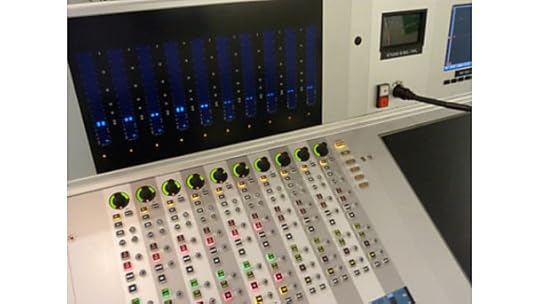
Mixing console level meters
So what does loudness measurement entail and why has it taken so long to be adopted by broadcasters?
Most of us are familiar with audio level meters of one sort or another. These range from simple bar-graphs on inexpensive portable recorders to the more sophisticated instruments used in professional studios. But they share the common purpose of helping us to operate audio equipment within its optimum signal range.
If levels are too low, noise from the electronics may intrude, too high and the audio signal might exceed the capabilities of the electronics and cause clipping (a gross form of distortion in which the peaks of an audio waveform are literally ‘clipped off’). Either way, audio quality will suffer.
A key requirement of a level meter is that it responds to sounds across the full audio spectrum. It must also show signal levels for transient sounds such as cymbal crashes, gunshots and anything else used for dramatic effect.
If these fail to register properly because a meter responds too slowly, clipping may still occur.
Historically, level meters have been based around simple moving-coil instruments whose response time is limited by mechanical inertia. The designers recognised this and offset the calibration to allow some headroom for short transients that the meter was not capable of registering.
In other words the maximum scale marking (or start of a red warning sector) would always be slightly below what partnering equipment could cope with.
Two of the most common types of level meter used by audio professionals are the VU (Volume Units) meter and the PPM (Peak Programme Meter). Although recent incarnations of these meters use inertia-free electronic displays their slow response is retained because it is part of a standard specification.
Meters such as the PPM were not specifically designed to measure loudness. Loudness is subjective whereas audio level is an objective measurement of voltage at a particular point in an audio signal chain.
Some traditional level meters give a fair indication of relative loudness, at least between similar types of sound. They can be caught out by some types of programme. With experience, users learn to interpret the readings but inconsistencies do arise.
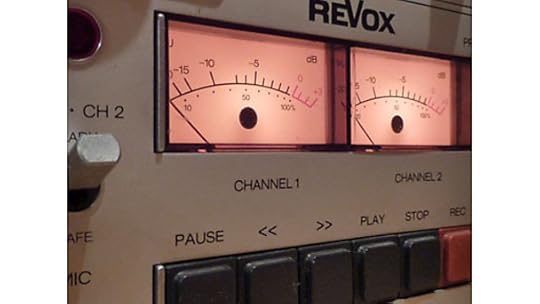
Moving-coil VU meters
So why are broadcasters talking about loudness measurement at the moment?
Research into the subject is not new, but it’s only recently that a set of international recommendations has come together.
Part of the impetus for this work stems from complaints to broadcasters about loudness variations. There has also been concern about ‘loudness wars’ within the music industry that has resulted in more and more compression of dynamic range being applied to recordings.
In extreme cases (aka ‘hyper-compression’) the result may indeed be LOUD but with a flat, lifeless quality that makes for uncomfortable listening.
There is a whole culture of audio production that has been based around using excessive amounts of compression and peak level control, the removal of headroom from signal chains and a failure to appreciate the problems that these practices can cause.
By shifting the emphasis towards controlling loudness rather than just audio level it’s hoped that better recordings with more natural dynamics will become the norm rather than the exception.
For broadcasters the main expectation is that the adoption of a common ‘loudness target’ will improve consistency. Programme interchange between production companies and broadcasters will benefit, leading to fewer gross loudness discrepancies for the listener.
The recommendations being adopted for loudness measurement are underpinned by a document with the snappy title ITU-R BS.1770-3 and are based on the subjective loudness of a range of typical types of programme.
The basic measurement principles involve a modified frequency response (known as K-weighted), summation of individual audio channels and the use of relatively slow meter attack times. Together these produce a measurement that correlates closely with subjective loudness and enables a loudness value to be specified for anything from a short clip of audio to an entire programme.

Twin-needle PPM
So what units are used for this loudness measurement? We are familiar with digital audio levels being quoted in terms of decibels with respect to full scale, or dBFS for short. Loudness measurement has adopted the acronym LUFS, which stands for Loudness Units with respect to Full Scale.
To keep things simple LUFS are equivalent to dBFS for a 1kHz sine wave (tone) signal. So for example, commonly used line-up tone at -18 dBFS when fed to both channels of a stereo signal chain will also read -18 LUFS on a loudness meter. On speech, music and so on the readings on a loudness meter will of course be very different to those on other types of meter!
The target loudness value that the European Broadcasting Union (EBU) has recommended for programmes is -23 LUFS. That may seem a bizarrely random number but in fact it was chosen following extensive measurement of real programme material.
It allows adequate headroom for peaks and is also not too far removed from current (EBU) broadcast practice. This is important because it should enable most archive recordings to be accommodated within the new recommendations with only modest adjustment.
Another consideration was periods of very low level audio or silence within a programme. These will tend to drag the average loudness value down and may give a misleading result in some cases. So it’s been proposed that an optional ‘gate’ may be used to freeze the measurement when the loudness drops below a certain threshold.
The use of a loudness meter on its own would be risky because it does not show very brief transient sounds. This is by design, such sounds don’t contribute much to average programme loudness so the meter is reflecting that. But it does mean that care is needed to avoid clipping the signal.
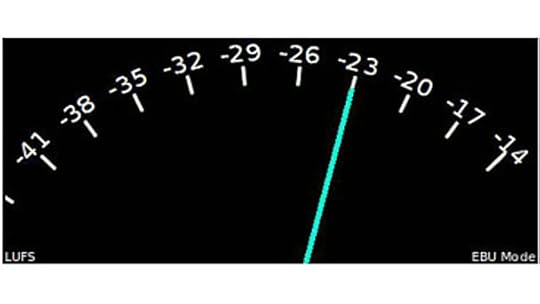
EBU Loudness meter - on target for -23 LUFS!
This is partly accommodated by allowing adequate headroom, but ITU-R BS.1770-3 also defines a supplementary peak-reading meter for use with a loudness meter. The specification for this has also addressed a problem that can arise with some meters that claim to show dBFS.
Whilst ‘decibels with respect to full scale’ might seem an unambiguous term, some meters define full scale in terms of digital sample peak which does not necessarily correspond to the peak of an audio waveform. Better meters use oversampling (4x or more) to increase their resolution and this is the approach specified by the ITU-R spec.
To remove ambiguity, meters that conform to the specification are described as reading ‘decibels with respect to true peak’ (dBTP). Don’t panic, it’s not yet another meter scale to contend with – it’s basically still dBFS, but certified to be accurate! For convenience a dBTP meter may be included alongside the loudness scale in a single instrument.
I referred to the recent loudness standards as being international. In fact there are minor differences between the loudness practices being adopted by American and European broadcasters
but these do not have a significant impact on the final results.
Implementation of loudness control in the USA is now subject to legislation in the form of their Commercial Advertisement Loudness Mitigation (CALM) act. Similar legislation is also being adopted by some European countries. Guidance on how to comply can be found in EBU Recommendation R 128.
The application of Recommendation R 128 is not going to make a difference overnight, but we believe that it is a step in the right direction and are working with other broadcasters in the pursuit of a common loudness standard.
Ian Astbury is a senior investigations engineer in the Technology for BBC Radio team.
For more behind the scenes information on developments at the BBC visit the BBC Radio blog and the BBC Research & Development site.
April 2, 2013
Testing for BBC Online: The creation of the POD Test Group
I’m Richard Lyon, the head of test for the recently formed Test Group within Future Media Programmes & On Demand (POD) known as ‘POD Test’.
Programme & On Demand’s output includes the BBC iPlayer product, the iPlayer Radio product, /programmes, social plugins and personalisation capabilities across mobile, tablet, desktop and TV.
With our range of web offerings and apps and the variety of platforms we deliver them on, testing is a huge undertaking for Programmes & On Demand.
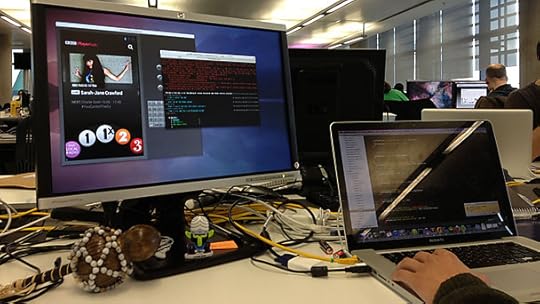
Testing elements of iPlayer Radio
Over the last few years each of the product teams within Programmes & On Demand has built up its own testing capability separately.
The test discipline both at the BBC and in the industry in general has evolved rapidly during this time from traditional testing at the end of development to extensive use of automation and the adoption of Behaviour Driven Development (BDD).
BDD is a software development approach with test at its core. Functionality is described by tests written with the customer. Software is then written to make those tests pass to ensure a tight and highly visible coupling between the customer’s requirements and the software that is produced.Test is now at the point where it is the ‘glue’ between product management, development and project management.
Tests describe how a product should behave, drives software design and describes the health and risks of a product in development.
Recently we’ve brought the separate test teams into a single POD Test group for a number of reasons:
Bringing the testers together into a single test group will allow us to address these changes more effectively.
As Programmes & On Demand is organised by product area the POD Test team will be the only discipline group within Programmes & On Demand.
That’s not to say that we’ll be adopting an agency model where we ‘hire out’ testers into the product teams, far from it.
We place high value in our testers being embedded in product teams because of the knowledge they gain about the products they work on and the pride they have in those products.
But it will allow more flexibility when we need it for testers to move into different product teams to share innovation, respond to prioritisation or if potentially they just fancy a change.
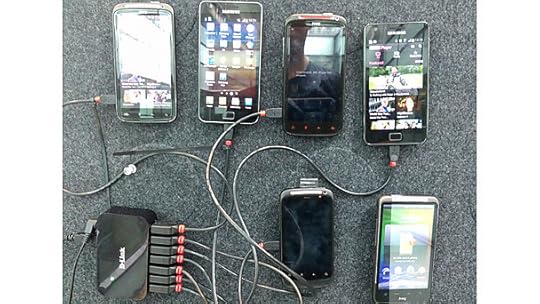
Testing on multiple devices
A little bit about how we test.
Although we invest heavily in automation in test we still place a lot of emphasis on manual testing.
There are some areas that can only be tested manually, particularly when it comes to video and audio quality and some defects that will only ever be uncovered by a skilled exploratory tester.
However we have seen some tremendous efficiencies achieved by automation, reducing the need for time consuming manual test cycles of repetitive checks.
There are also additional benefits we see from automated test suites such as providing ‘living documentation’. The automated tests not only document a system’s requirements but can be executed at any time to ‘check themselves’ against the system they describe to ensure the system is still meeting those requirements.
We aspire to a BDD approach where we define features in a ‘user story’ format. A User story is written in natural language but to a strict format that describes who a feature is for, what the feature is and what benefit that feature delivers, ( e.g. ‘As a …, I want…, so that…’).
Then representatives from the product, engineering and POD Test team come together to flesh out the behaviour of that user story by writing acceptance tests for it.
Acceptance tests will add more detail to the user story. Like the user story they are written to a strict format that describes pre-conditions, an event and an outcome (e.g. ‘Given…, when…, then…’).
The great benefit of user stories and acceptances tests is that they provide a shared artefact that makes sense to a product owner as a description of their requirements, engineering as a specification to build to and test as a set of executable tests.
Traditionally these may have existed as three separate documents that very quickly become out of sync leading to misunderstandings and delays.
Where possible the tests are automated, either by the developers coding the feature or with the assistance of a developer-in-test.
When the tests are passing then the feature is ‘done’, whilst the automated tests build up into a regression pack allowing us to check that new features we develop aren’t breaking existing functionality.
Device testing is one of the biggest challenges we have. This means ensuring that new devices such as mobiles, connected TVs, set top boxes, games consoles and other connected devices will work with our products and that new video profiles and formats and new features perform as expected across existing devices.
For mobile and connected TVs our testing can’t possibly cover all devices. Instead we have to prioritise based on stats from audience use, which tells us which are the most popular devices.
We may then categorise these further, grouping similar devices together in order to give us as broad coverage as possible.
The way we test our products never stands still. As we continue to evolve and develop our products new challenges arise about how we test them, the introduction of responsive design being a recent example.
We’ll be blogging more about how we’re tackling some of these challenges in POD Test and about how we test some of our big product launches this year, so keep checking back here and we’ll let you know how we’re getting on.
It would be great to hear your feedback, please leave a comment and tell us what you think.
Richard Lyon is the head of test for the POD Test Group.
Testing for BBC online: The creation of the POD Test Group
I’m Richard Lyon, the head of test for the recently formed Test Group within Future Media Programmes & On Demand (POD) known as ‘POD Test’.
Programme & On Demand’s output includes the BBC iPlayer product, the iPlayer Radio product, /programmes, social plugins and personalisation capabilities across mobile, tablet, desktop and TV.
With our range of web offerings and apps and the variety of platforms we deliver them on, testing is a huge undertaking for Programmes & On Demand.

Testing elements of iPlayer Radio
Over the last few years each of the product teams within Programmes & On Demand has built up its own testing capability separately.
The test discipline both at the BBC and in the industry in general has evolved rapidly during this time from traditional testing at the end of development to extensive use of automation and the adoption of Behaviour Driven Development (BDD).
BDD is a software development approach with test at its core. Functionality is described by tests written with the customer. Software is then written to make those tests pass to ensure a tight and highly visible coupling between the customer’s requirements and the software that is produced.Test is now at the point where it is the ‘glue’ between product management, development and project management.
Tests describe how a product should behave, drives software design and describes the health and risks of a product in development.
Recently we’ve brought the separate test teams into a single POD Test group for a number of reasons:
Bringing the testers together into a single test group will allow us to address these changes more effectively.
As Programmes & On Demand is organised by product area the POD Test team will be the only discipline group within Programmes & On Demand.
That’s not to say that we’ll be adopting an agency model where we ‘hire out’ testers into the product teams, far from it.
We place high value in our testers being embedded in product teams because of the knowledge they gain about the products they work on and the pride they have in those products.
But it will allow more flexibility when we need it for testers to move into different product teams to share innovation, respond to prioritisation or if potentially they just fancy a change.

Testing on multiple devices
A little bit about how we test.
Although we invest heavily in automation in test we still place a lot of emphasis on manual testing.
There are some areas that can only be tested manually, particularly when it comes to video and audio quality and some defects that will only ever be uncovered by a skilled exploratory tester.
However we have seen some tremendous efficiencies achieved by automation, reducing the need for time consuming manual test cycles of repetitive checks.
There are also additional benefits we see from automated test suites such as providing ‘living documentation’. The automated tests not only document a system’s requirements but can be executed at any time to ‘check themselves’ against the system they describe to ensure the system is still meeting those requirements.
We aspire to a BDD approach where we define features in a ‘user story’ format. A User story is written in natural language but to a strict format that describes who a feature is for, what the feature is and what benefit that feature delivers, ( e.g. ‘As a …, I want…, so that…’).
Then representatives from the product, engineering and POD Test team come together to flesh out the behaviour of that user story by writing acceptance tests for it.
Acceptance tests will add more detail to the user story. Like the user story they are written to a strict format that describes pre-conditions, an event and an outcome (e.g. ‘Given…, when…, then…’).
The great benefit of user stories and acceptances tests is that they provide a shared artefact that makes sense to a product owner as a description of their requirements, engineering as a specification to build to and test as a set of executable tests.
Traditionally these may have existed as three separate documents that very quickly become out of sync leading to misunderstandings and delays.
Where possible the tests are automated, either by the developers coding the feature or with the assistance of a developer-in-test.
When the tests are passing then the feature is ‘done’, whilst the automated tests build up into a regression pack allowing us to check that new features we develop aren’t breaking existing functionality.
Device testing is one of the biggest challenges we have. This means ensuring that new devices such as mobiles, connected TVs, set top boxes, games consoles and other connected devices will work with our products and that new video profiles and formats and new features perform as expected across existing devices.
For mobile and connected TVs our testing can’t possibly cover all devices. Instead we have to prioritise based on stats from audience use, which tells us which are the most popular devices.
We may then categorise these further, grouping similar devices together in order to give us as broad coverage as possible.
The way we test our products never stands still. As we continue to evolve and develop our products new challenges arise about how we test them, the introduction of responsive design being a recent example.
We’ll be blogging more about how we’re tackling some of these challenges in POD Test and about how we test some of our big product launches this year, so keep checking back here and we’ll let you know how we’re getting on.
It would be great to hear your feedback, please leave a comment and tell us what you think.
Richard Lyon is the head of test for the POD Test Group.
March 29, 2013
What’s on BBC Red Button 30 March – 6 April
Bach: A Passionate Life

John Eliot Gardiner
John Eliot Gardiner goes in search of Bach the man and the musician in Bach: A Passionate Life on Saturday at 8pm on BBC Two. His portrait reveals a complex and passionate artist, a warm and convivial family man and at the same time a rebellious spirit who wrote timeless music that is today known world-wide. Gardiner follows in Bach’s footsteps, but most of all he uses music to reveal the real Bach. Press red after the programme to enjoy concert performances.
Available on Freesat/Sky/Virgin Media/Freeview
Saturday 30 March, 9:25pm-2:25am
Live Lounge

Olly Murs
There’s more music this week on BBC Red Button. Radio 1’s world-famous Live Lounge hosts emerging musicians and superstars each month. Their stripped-back performances and cover versions have been listened to by millions - and now you can watch it too. In April you can see Nina, Olly Murs, The xx, Laura Mvula, Theme Park and Katy B.
Available on Freesat/Sky/Virgin Media/Freeview
Monday 1 April 12pm-2:30pm, 6pm-6am
Tuesday 2 April 6am-7am, 12pm-2pm, 7:30pm-6am
Wednesday 3 April 6am-7am, 12pm-2pm, 9pm-6am
Thursday 4 April 6am-7am, 8:45pm-6am
Friday 5 April 6am-7am, 8pm-12am
Sport highlights
Forget that we’re all wrapped up in coats – you know spring is here when the Boat Race glides onto our screens. Clare Balding introduces live coverage of the 159th Boat Race on London's River Thames, with Oxford University hoping to avenge last year's dramatic defeat to Cambridge University. If you miss the live coverage on BBC One (Sunday, 3.15pm) you can watch it replayed on Red Button at 7pm and 9pm, and at 6am on Monday morning.
Other Sport highlights include Moto GP Free Practice in Qatar, Triathlon in Auckland, Scrum V rugby and the ever popular Final Score and Football League Show for football fans.
Available on Freesat/Sky/Virgin Media/Freeview
For the latest information refer to the BBC Sport website
Please note - all Red Button times are subject to change at short notice.
Antiques Roadshow Play Along
Fiona Bruce and the team pays a visit to Lord Byron's former home, Newstead Abbey in Nottinghamshire. Objects featured in the show include a giant dog collar from Victorian days, a collection of early royal relics, and boxing gloves once used by the young poet Byron.
You can join in with the programme by pressing red to guess the valuations in real time. Your score is ranked and you’ll discover whether you’re an antiques armchair expert or more of a novice.
You can now also play along on a mobile or tablet by downloading the play along app. Find out more and read the step-by-step instructions to play via Red Button. Don't forget to tweet your scores to #antiquesroadshow.
Available on Sky and Freeview
Sunday 31 March, 7:55pm-9pm
CBBC’s Easter Extra
CBBC Extra is celebrating Easter with a cracking Easter Special presented by Chris and Cel that previews some of the great CBBC shows on over the holidays!
See what happened when Dodge met the Daredevil, check out exclusive sneak peeks of Deadly Bloopers and Dani’s Castle plus there is plenty of fun in the office with Chris and Cel.
As always you can read Chris and Dodge’s blog, check out the answers to some of your questions and read your horoscopes as written by Yonko.
Go on, press red… You know you want to!
Available on Freesat/Sky/Virgin Media/Freeview
Saturday 30 March 7am-2:30pm
Sunday 31 March 12pm-6pm
Monday 1 April 7am-12pm
Tuesday 2 April 7am-12pm, 2pm-7:30pm
Wednesday 3 April 7am-12pm, 2pm-7:45pm
Thursday 4 April 7am-3:45pm
Friday 5 April 7am-12pm, 1pm-3.45pm
March 26, 2013
Making the TV Application Layer Open Source
I’m Pete Lasko and I am a technical product manager in the BBC’s Future Media TV and Mobile Platforms department.
Last September Roux Joubert blogged about some of the challenges we face in building BBC Connected TV applications and the actions we took.
Today I would like to tell you how the BBC is making it easier to build connected TV applications and how we are sharing this information on open source to benefit the rest of the industry.

Building for Connected TV is complicated
The TV Application Layer originated from our ambition to run BBC iPlayer, News and Sport applications for Connected TVs on as many different devices as possible.
There are hundreds of different devices in the marketplace and they all use slightly different technology to achieve the same result.
Having figured out how to build an application on a specific device we want to use this knowledge to build additional applications for that device.
Our answer to this challenge is the TV Application Layer (TAL). By abstracting the differences between devices and creating a number of TV-specific graphical building blocks (like carousels, data grids and lists), we provide a platform upon which we can build our applications.
About the TV Application Layer
The purpose of the TV Application Layer is to allow you to write an application once and for this to then work on all HTML based Connected TV Devices.
Comprising of a number of JavaScript libraries, The TV Application Layer operates across a wide range of different Connected TVs, IPTVs, games consoles, set top boxes and Blu-ray devices in the market.
The common feature of these devices is that they all get used via your TV, still the best place for consuming video content.
As each new application faced a similar set of device specific challenges, such as media playback, animation or networking, we set about making the TV Application Layer a standalone product that could support our entire Connected TV product needs both now and in the future.
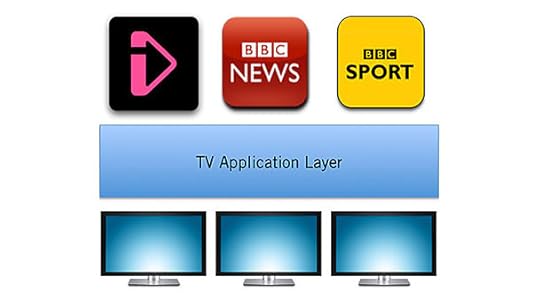
Because the abstraction code is modularised into the specific areas that vary between devices, we effectively have a selection of options that we can configure for each device.
This allows us to add new devices to our applications simply by recognising the device’s browser and applying a specific configuration appropriate to that device, without modifying the application’s code.
Therefore we can deploy our applications on devices that might have different key features such as video playback, animation, persistent storage and remote control key codes, by creating a new configuration file.
The TV Application Layer also provides some TV-specific graphical widgets for use in new application development. For example: the menu carousel used in iPlayer.
We find that the TV Application Layer allows us to concentrate on building the features our audience want rather than addressing device specific differences that we have already solved before.
Making the TV Application Layer Open Source
We are pleased to announce that the BBC is sharing the TV Application Layer with the wider industry.. The code and documentation are available via the open source repository GitHub.
This is not just a copy of our code. This is the live, latest code that we use to build and continually develop our Connected TV applications.

Why share it?
You may be wondering why the BBC is sharing the TV Application Layer.
Firstly, Open Source code allows other parties to contribute suggestions to the TV Application Layer. This makes the product better for everyone who uses it, it allows our applications to work on more devices and therefore reach more of our audience.Sharing the TV Application Layer should make building applications on TV easier for others, helping to drive the uptake of this nascent technology. The BBC has a history of doing this and we are always looking at new ways to reach our audience.The BBC is keen to encourage the connected TV market. As the BBC licence fee has funded this work, we can create more value for money by sharing this work with others in the industry, for the benefit of our audiences.We hope that this stimulus helps get more offline people ‘connected’, contributing towards the BBC’s Media Literacy campaign as well as the government’s Digital Britain initiative.Finally, the BBC is always looking at ways in which it can partner with the wider industry. This is a great way to allow application developers to create applications for a large range of Connected TV Devices. Equally it helps device manufacturers increase the number of applications for their devices.
A practical solution
We have found that creating and using the TV Application Layer has allowed us to better spend our time improving our existing applications and building new ones like the Connected Red Button that Matt Coulson blogged about previously.
We hope that by making the TV Application Layer available via open source you too can benefit and that we'll all see more high quality applications on TVs. Find out more on the TV Application Layer website.
It would be great to hear your feedback and comments.
Pete Lasko is a technical product manager, BBC Future Media TV and Mobile Platforms.
March 22, 2013
What’s on BBC Red Button 23-30 March
Doctor Who – The Bells of Saint John: A Prequel
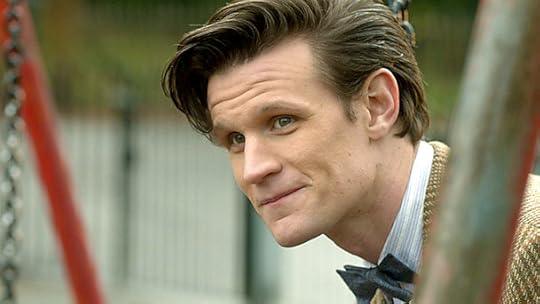
Matt Smith as Doctor Who
Look who’s back! Can’t wait for the new Doctor Who series? Press the Red Button and whet your appetite with an exclusive prequel showing the Doctor take a break on Earth after feeling despondent that he can’t find Clara.
The new series of Doctor Who begins on BBC One on 30 March.
Available on Freesat/Sky/Virgin Media/Freeview
Saturday 23 March 5.15pm 8.30pm
Tuesday 26 March 7pm-6am
Wednesday 27 March 6am-7am, 7.30pm-6am
Thursday 28 March 6am-7am, 7.30pm-6am
Friday 29 March 6am-7am, 7.30pm-6am
Saturday 30 March 6am-7am
Antiques Roadshow play along
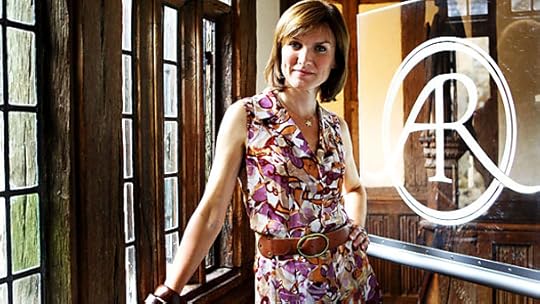
Fiona Bruce on the Antiques Roadshow
A second visit to Chatham's Historic Dockyard finds Fiona Bruce and the team busy as the people of Kent turn out in big numbers to share their family heirlooms. Treasures include jewels once gifted in appreciation by King Farouk of Egypt, a mandolin made by a German POW and a valuable wine bottle found in a skip.
Over one million people have already pressed red to guess the valuations of objects featured in real time – join in and find out if you’re an antiques expert or novice when your score is ranked.
You can now also play along on a mobile or tablet by downloading the play along app. Find out more and read the step-by-step instructions. Don't forget to tweet your scores to #antiquesroadshow.
Available on Sky and Freeview:
Sunday 24 March, 7.55pm-9pm
CBBC Extra Behind the Scenes Special Video
CBBC Extra is lifting the lid on some of CBBC’s biggest brands this week as Chris and Cel serve up an exclusive Behind the Scenes Special. There are not one but three access all areas films that reveal what goes into making some top CBBC shows!
Hacker sniffs out the story behind Officially Amazing, CBBC’s brand new record-breaking show. Sam & Mark reveal the secrets behind the hidden cameras that go into filming Sam and Mark’s Big Friday Wind Up and we join the Who Let the Dogs Out and About team on tour in Leeds.
As always you can read Chris and Dodge’s blog, check out the answers to some of your questions and read your horoscopes as written by Yonko.
CBBC Extra also has some Eggstra Easter treats in store, so go on, press red… You know you want to!
Available on Freesat/Sky/Virgin Media/Freeview:
Saturday 23 March, 7am-2.15pm
Sunday 24 March 12noon-2pm
Monday 25 March 5pm-7.30pm
Tuesday 26 March 7am-11am
Wednesday 27 March 7am-7.30pm
Thursday 28 March 7am-12noon, 1pm-7.30pm
Easter Extra
Friday 29 March 7am-7.30pm
Saturday 30 March 7am-2.30pm
Sport highlights
It's a busy weekend for BBC Sport and on Saturday you can keep up to date with the exciting qualifying sessions in the F1 Malaysian Grand Prix. For those with Olympics nostalgia we also have live rowing from the World Cup in Sydney from 11pm.
There’s athletics action on Sunday, when we bring you coverage of the World Cross Country Championships in Poland. And of course there’s the weekend’s main event, the Malaysian Grand Prix main race - we give you plenty of opportunities to catch the highlights.
Not to be forgotten, football fans can get their weekly serving of the Football League Show across the weekend while The Super League Show offers viewers another chance to catch up with the weekend's Rugby League action as the teams prepare for the busy Easter period.
Available on Freesat/Sky/Virgin Media/Freeview.
For the latest information refer to the BBC Sport website
Please note - all Red Button times are subject to change at short notice.
March 21, 2013
The Voice UK: Putting digital at the heart of the format
I’m Sarah Clay, online exec for BBC Drama and Entertainment. I look after programmes such as The Voice UK, The Apprentice, Britain Unzipped and Being Human, brands that work really well online as a way of expanding the viewers’ experience beyond TV.
The Voice is a Saturday night entertainment show on BBC One. Coaches Jessie J, will.i.am, Sir Tom Jones and Danny O’Donoughue search for the UK’s best singing talent based purely on the quality of their voice.
The show is exciting as digital is at the heart of the format. Social media gives fans a direct line to the talent and to the show. Where else would you get will.i.am tweeting on stage mid song?

Exclusive access on Facebook – Danny having his chest waxed by Jessie for Comic Relief
The first series of The Voice was huge from a digital perspective and the website was one of our top performing BBC programme sites during the period it was on air.
The show dominated social chatter, trending regularly on Twitter both globally and in the UK. It attracted 215k Twitter followers plus 250k Facebook fans.
There have also been over 113 million global YouTube views to our video content since launch.
Series two is going to be even bigger online than last year. Fans can look forward to more exclusive online videos, informal backstage images and content created especially for our Facebook and Twitter fans to make the experience feel more personal and fun.
We’re also expanding our social media platforms to include Instagram, Pinterest and Tumblr.
Content will be tailored to each platform: showcasing our style and fashion related content on Pinterest, delivering more light hearted fun content and animated gifs on Tumblr and giving fans access to a wealth of backstage pics via Instagram.
We’re bringing the content to the fans so they can connect with The Voice whenever and wherever they choose.
This year, we will also be introducing a new live blog that will curate the best social media content and conversation from across the web and showcase it on The Voice UK website.
A great example is the recent Q&A with David Attenborough run on a live blog alongside the BBC One show Africa. User’s tweets, questions, pictures and even clips can be pulled into a stream and displayed on the BBC website.
On top of all this we’re launching a brand new companion experience called The Voice Predictor Game.

The Voice Predictor Game
We’re always looking for fun and exciting ways to expand the viewers' experience beyond TV, especially as more and more internet connected devices make their way into people’s living rooms.
How can we tap into the passions and behaviours that the show inspires and give people something extra?
The Voice Predictor Game builds on the success of the recent Antiques Roadshow play-along game and will be available on the BBC Voice UK website as a Flash game and later on mobile iOS and Android devices to downloaded as an app.
As we saw with the blind auditions in series one, fans really loved the idea of second guessing the coaches. They also liked the idea of experiencing the show as the coaches do: listening to the artists without seeing them. Cue the audition predictor game.
Players get to listen to six exclusive audition previews from the upcoming show and have to predict, based on their voices, whether or not the acts will make it through on Saturday night.
They can share their predictions on Facebook and Twitter and see how well they know the coaches by tuning into to Saturday’s show.
Viewers can also play-along during the show. As each artist auditions, the players have to predict which team they will end up on.
We're hoping the game will appeal to our younger fans but also mirror the success of other BBC companion experiences, such as the Antiques Roadshow play-along game where we saw mainstream BBC One audiences getting involved, making their viewing experience even better.
We’ll be updating you throughout the series, sharing developments and letting you know how it’s going. We’re hoping lots of you will want to join in, either by predicting who will get through via the app, or joining the conversation on social media.
It’s always great to hear what you think, so looking forward to hearing your comments below.
Where to find us...
Sarah Clay is online exec for BBC Drama and Entertainment.
BBC's Blog
- BBC's profile
- 28 followers



